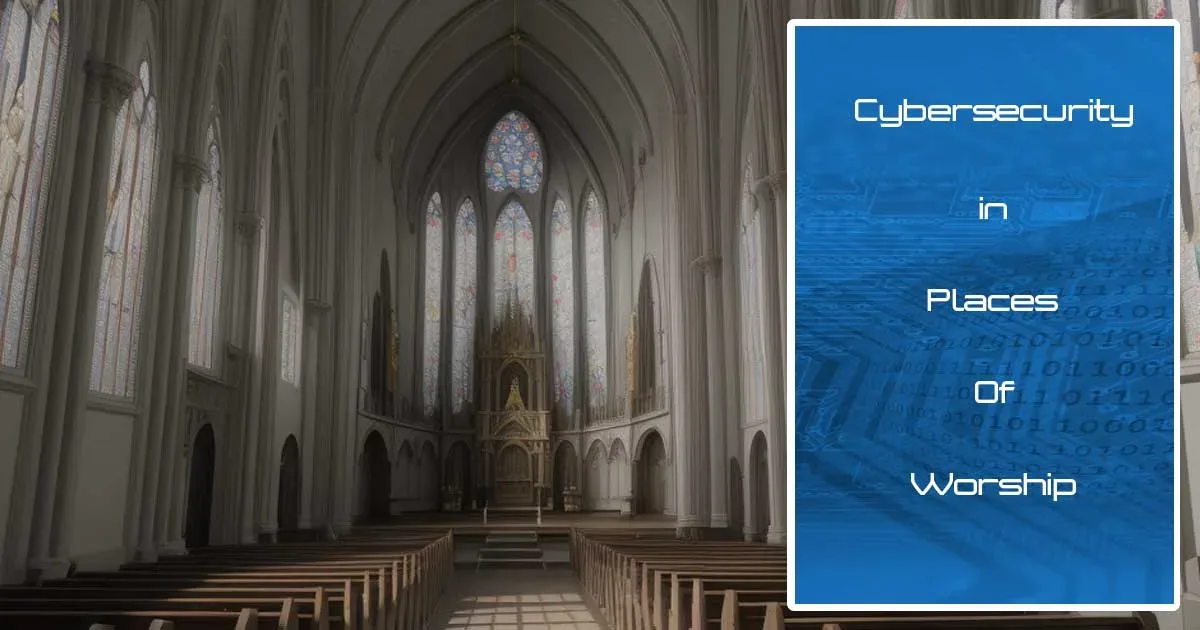Cybersecurity Practices for Religious Institutions like churches and synagogues have embraced technology for everything from online tithing to streaming worship services. This digital evolution, however, introduces significant cybersecurity challenges. With sensitive data at risk, it’s imperative for these sacred spaces to fortify their digital defenses against cyber threats. This guide explores the cybersecurity landscape facing religious organizations and outlines essential strategies for safeguarding their digital domains.
Navigating the Cyber Threat Landscape for Religious Institutions
- Phishing Schemes: These deceptive emails can lead unsuspecting staff or members to divulge confidential information.
- Ransomware Dangers: Malicious software that can lock institutions out of their own data, demanding a ransom for access.
- Data Breaches: Unauthorized access incidents can expose sensitive donor and member information, eroding trust.
Cybersecurity Practices for Religious Institutions
Comprehensive Training
Objective: Establish a continuous learning environment for all members of the institution, including staff, clergy, and volunteers, focusing on the latest cybersecurity threats and prevention techniques.
Implementation: Create a structured cybersecurity curriculum that includes:
- Regular training sessions and workshops.
- Simulation exercises, such as mock phishing attempts, to test and improve threat recognition skills.
- Access to online resources and updates on new cyber threats.
Data Protection Tools
Objective: Implement robust technological defenses to safeguard sensitive data against unauthorized access and cyber intrusions.
Implementation:
- Install and maintain state-of-the-art firewalls to monitor and control incoming and outgoing network traffic based on predetermined security rules.
- Apply data encryption for all stored and transmitted data, ensuring that information remains secure and unreadable to unauthorized users.
Consistent Data Backups
Objective: Ensure the availability and integrity of data through systematic backup processes, protecting against data loss from cyber incidents or other disasters.
Implementation:
- Schedule regular data backups, both onsite and offsite, to multiple secure locations.
- Test backup systems periodically to ensure data can be effectively restored.
Enhanced Access Control
Objective: Strengthen access to digital systems and sensitive information by implementing Multi-Factor Authentication (MFA) across all user accounts.
Implementation:
- Require MFA for all internal systems and any cloud-based platforms, significantly reducing the risk of unauthorized access due to compromised credentials.
VPN Protocols
Objective: Secure remote access to the institution’s network, ensuring that communications are encrypted and protected from interception.
Implementation:
- Encourage or mandate the use of Virtual Private Networks (VPNs) for any staff or clergy accessing the institution’s systems remotely, providing secure and private access.
Cybersecurity Practices for Religious Institutions: Online Donations
Objective: Ensure that the congregation’s generous contributions are made through secure, encrypted, and compliant platforms.
Implementation:
- Select online donation platforms that are recognized for their strong security measures and compliance with financial regulatory standards, such as PCI DSS.
Software Vigilance
Objective: Protect against vulnerabilities and cyber threats by keeping all software, especially security-related programs, up-to-date.
Implementation:
- Establish a routine process for updating all software applications, focusing on timely application of security patches and updates.
Preparedness for Incidents
Objective: Develop a comprehensive plan for responding to cyber incidents, minimizing impact and facilitating a swift recovery.
Implementation:
- Craft an incident response plan that includes identification, containment, eradication, and recovery procedures.
- Conduct regular drills to ensure all team members are familiar with their roles in the event of a cyber incident.
- Establish communication protocols for notifying affected parties and authorities if necessary.
By expanding on these critical cybersecurity practices for religious institutions, you can build a robust defense against the digital threats they face, ensuring the safety and security of their congregations’ data and maintaining the trust placed in them.
Integrating Physical and Digital Security Measures
- Wi-Fi Security: Secure and monitor Wi-Fi networks accessible to congregants, preventing unauthorized network intrusions.
- Surveillance Strategies: Implement camera systems not just for physical security but also as a deterrent against digital crime.
- Access Restrictions: Limit physical access to critical technical infrastructure to authorized personnel only.
Promoting Digital Etiquette and Cyber Awareness
- Internet Use Education: Encourage safe browsing practices among congregation members and staff.
- Social Media Guidance: Offer insights into the advantages and potential hazards of social media engagement.
- Password Management: Stress the importance of robust, unique passwords for all online accounts.
- Community Workshops: Conduct cybersecurity workshops to elevate the digital literacy of your congregation.
- Informational Bulletins: Regularly communicate with your community about emerging cyber threats and protective practices.
- Youth Engagement: Utilize the digital proficiency of younger congregation members to promote a culture of cyber awareness.
Protect Your Faith Community with Cybersecurity Practices for Religious Institutions
As we navigate the complexities of the digital age, the security of your faith community’s data and privacy remains paramount. In the face of increasing cyber threats, taking proactive steps to safeguard your religious institution’s digital presence is not just advisable; it’s essential. From securing sensitive congregant information to ensuring the uninterrupted flow of your spiritual services online, the integrity of your cybersecurity measures speaks volumes about your commitment to your community’s safety and trust.
Don’t let cybersecurity concerns overshadow the sanctity of your mission. Reach out to cybersecurity professionals today to audit, enhance, and maintain your church or synagogue’s digital defenses. Embrace the peace of mind that comes from knowing your sacred space is protected both offline and online.
Contact us now to fortify your religious institution against digital threats and ensure a safe, secure environment for your faith community to thrive. Let’s work together to shield your sacred mission in the digital realm.
References:
- Cybersecurity & Infrastructure Security Agency. (n.d.). Cybersecurity Best Practices. Retrieved from https://www.cisa.gov/topics/cybersecurity-best-practices
- Rahayu, S. S., & Prasetijo, A. (2021). The role of information systems in enhancing the quality of religious services. Proceedings of the Bukittinggi Seminar on Psychology, 1(1). https://publisher.stipas.ac.id/index.php/pbs/article/view/88
Cybersecurity Practices for Religious Institutions – To Learn More:
Safeguard Your Future: Navigating the Evolving Cybersecurity Threat Landscape
Top 10 FAQs About Digital Defense: Mastering Cyber Security Risk Assessments for Businesses




